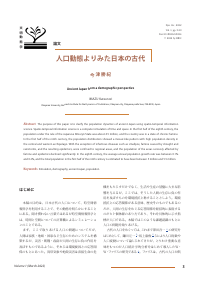

 人口動態よりみた日本の古代
人口動態よりみた日本の古代
| ID | 63024 |
| タイトル(別表記) | Ancient Japan from a Demographic Perspective
|
| JaLCDOI | |
| フルテキストURL | |
| 著者 |
今津 勝紀
Okayama University, Research Institute for the Dynamics of Civilizations
Kaken ID
publons
researchmap
|
| 抄録 | The purpose of this paper is to clarify the population dynamics of ancient Japan using spatio-temporal information science. Spatio-temporal information science is a computer simulation of time and space. In the first half of the eighth century, the population under the rule of the Japanese Ritsuryō State was about 4.5 million, and the country was in a state of chronic famine. In the first half of the ninth century, the population distribution showed a mosaic-like pattern with high population density in the central and western archipelago. With the exception of infectious diseases such as smallpox, famine caused by drought and rainstorms, and the resulting epidemics, were confined to regional areas, and the population of the areas seriously affected by famine and epidemics declined significantly. In the eighth century, the average annual population growth rate was between 0.1% and 0.2%, and the total population in the first half of the ninth century is estimated to have been between 5 million and 5.5 million.
|
| キーワード | Simulation
demography
ancient Japan
population
|
| Amo Type | 論文(Research Articles)
|
| 出版物タイトル |
文明動態学
|
| 発行日 | 2022-03
|
| 巻 | 1巻
|
| 出版者 | 岡山大学文明動態学研究所
|
| 開始ページ | 3
|
| 終了ページ | 20
|
| ISSN | 2436-8326
|
| 資料タイプ |
学術雑誌論文
|
| 言語 |
日本語
|
| 著作権者 | © 2022 by RIDC
|
| 論文のバージョン | publisher
|
| NAID |